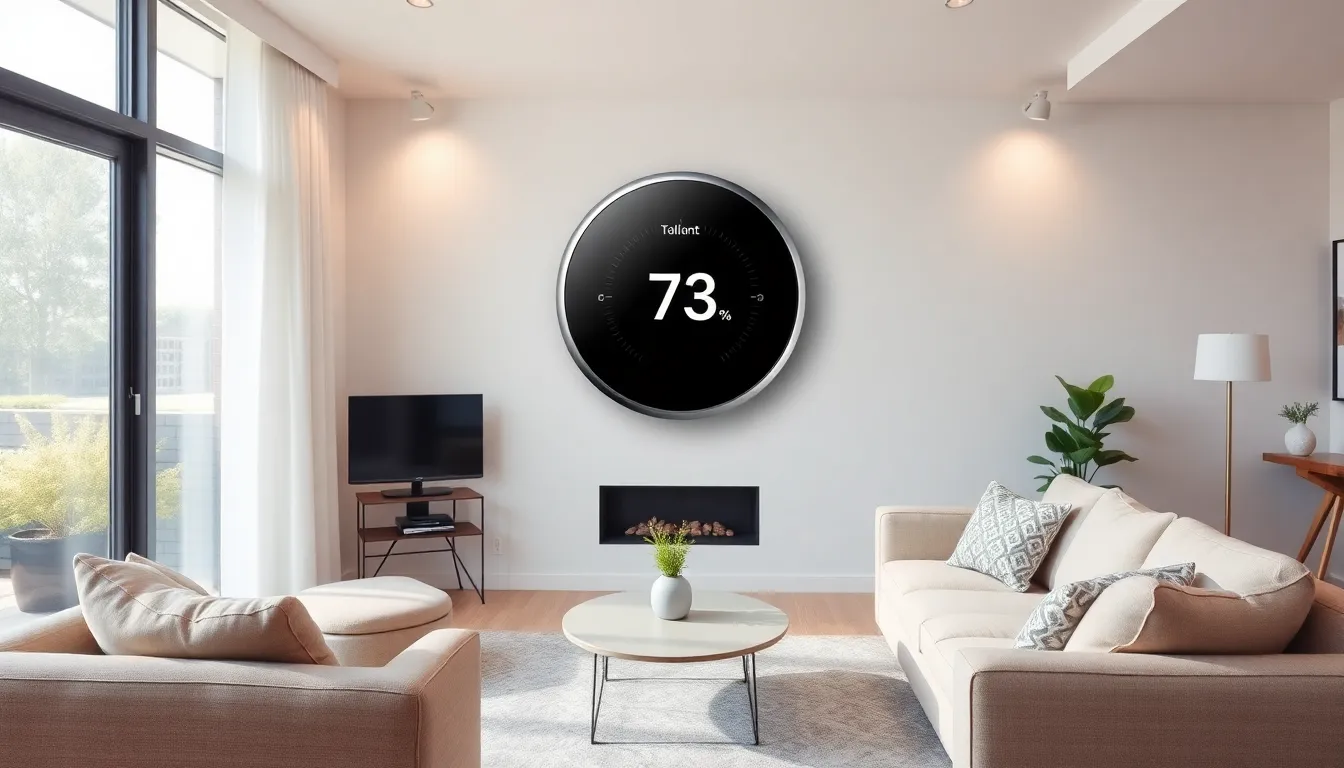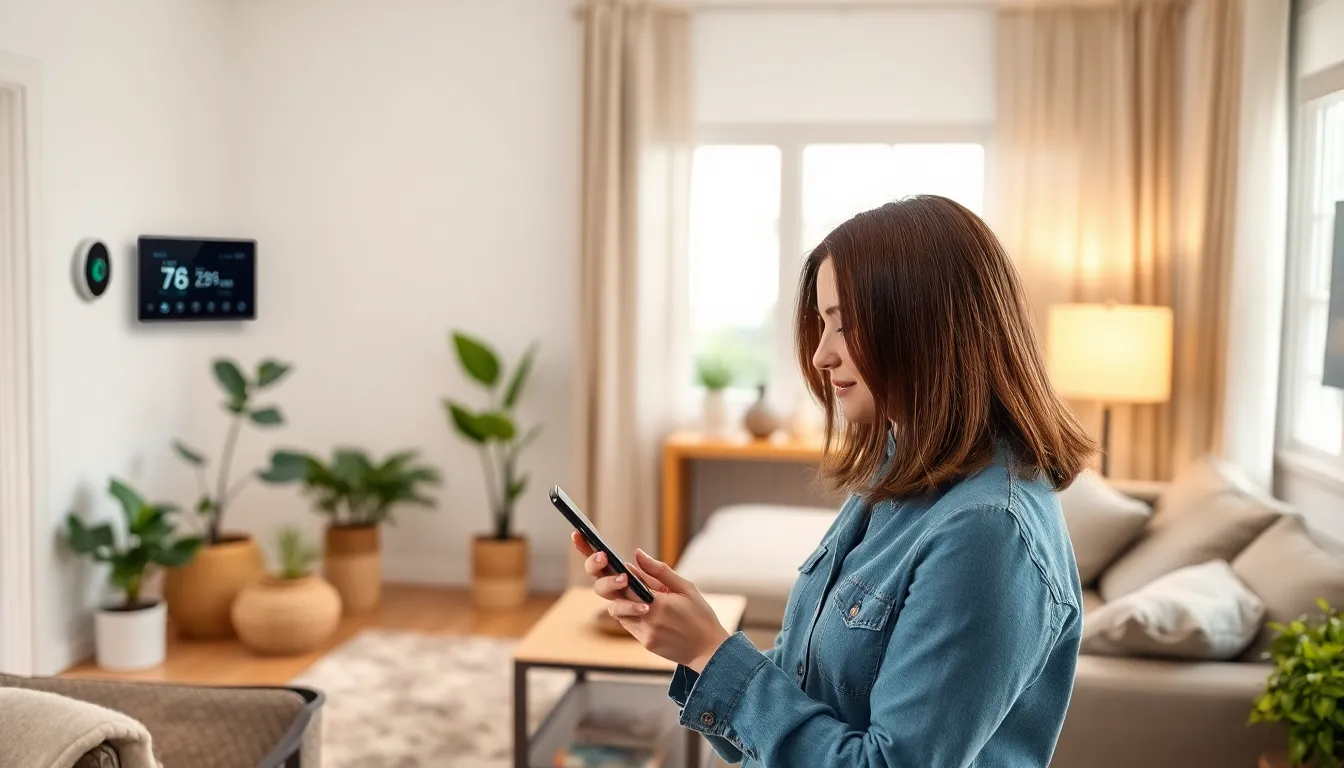Imagine walking into your home after a long day, only to be greeted by a cozy atmosphere that feels just right. Enter the smart thermostat, the unsung hero of modern living. This nifty gadget doesn’t just adjust temperatures; it learns your habits, anticipates your needs, and even saves you money—while making you feel like a tech-savvy genius.
Gone are the days of wrestling with dials or battling with outdated systems. With a smart thermostat, comfort is just a tap away. It’s like having a personal assistant for your climate control, minus the awkward small talk. Whether you’re at home or on a beach in Bali, you can control your home’s temperature from anywhere. So why not let a smart thermostat take the reins and keep you comfy while saving those precious dollars?
Table of Contents
ToggleOverview of Smart Thermostats
Smart thermostats represent a significant advancement in home automation, allowing users to manage their heating and cooling systems with ease. These devices learn user behavior patterns, which enables automatic adjustments to the home environment. By analyzing historical data, they optimize temperature settings to enhance comfort and efficiency.
Many smart thermostats come equipped with Wi-Fi connectivity, allowing remote access via mobile apps. Users can adjust temperatures from work, vacation, or while at home. Such versatility eliminates the limitations of manual thermostat adjustments.
Energy savings play a crucial role in the appeal of smart thermostats. According to the U.S. Department of Energy, homeowners can save up to 10 to 15 percent on heating and cooling costs by utilizing programmable features. These devices often provide detailed energy reports, helping users understand their consumption patterns.
Integration with other smart home devices further boosts the functionality of smart thermostats. Compatibility with systems like smart speakers or home assistants allows for voice-activated temperature adjustments. Users can create routines that automatically modify settings based on daily schedules.
Additionally, many models feature sensors that detect occupancy levels. This technology ensures energy is used efficiently, focusing on occupied areas while minimizing unnecessary heating or cooling. Such intelligent climate control contributes to a more sustainable living environment.
The ease of installation for smart thermostats also deserves attention. Most can be set up without professional assistance, allowing homeowners to enjoy modern heating and cooling solutions immediately. With features like filters and maintenance reminders, they encourage proactive home care.
Smart thermostats combine technology, energy efficiency, and convenience, making them indispensable in today’s households. As they continue to evolve, their impact on energy conservation and user comfort becomes increasingly significant.
Benefits of Using Smart Thermostats

Smart thermostats offer several advantages, enhancing home comfort and efficiency. These benefits touch on energy efficiency, cost savings, and overall comfort.
Energy Efficiency
Energy efficiency ranks high among the benefits of smart thermostats. They adjust heating and cooling according to user habits, reducing energy waste. Historical data analysis allows them to optimize temperature settings automatically. Many models utilize occupancy sensors to direct heating or cooling only to areas that are in use. This targeted approach significantly lowers energy consumption without sacrificing comfort.
Cost Savings
Cost savings represent a major incentive for adopting smart thermostats. Homeowners typically save about 10 to 15 percent on heating and cooling bills through their programmable features. Remote access features provide easy adjustments, helping users avoid unnecessary energy expenditure. By setting schedules aligned with daily routines, smart thermostats minimize energy wastage. Over time, these savings can lead to a noticeable reduction in monthly utility costs.
Enhanced Comfort
Enhanced comfort emerges as another key benefit. Smart thermostats learn user preferences, allowing for personalized temperature settings that adapt automatically throughout the day. Remote control capabilities mean users can adjust home temperatures from work or while traveling. Voice-activated adjustments integrate seamlessly with existing smart home systems, further enhancing convenience. Ultimately, smart thermostats create a more comfortable living environment tailored precisely to individual needs.
Features of Smart Thermostats
Smart thermostats come equipped with various innovative features that enhance home climate control. These capabilities elevate user experience and optimize energy consumption.
Learning Capabilities
Learning capabilities allow smart thermostats to adapt to individual user preferences. They analyze historical data to understand temperature trends and daily habits. This adaptability ensures that comfort levels remain high, as they adjust settings based on real-time feedback. Over time, these devices recognize patterns and can proactively manage temperatures, making homes more comfortable and energy-efficient. Homeowners benefit from personalized settings, as the thermostat learns what temperatures users prefer during different times of the day.
Remote Access
Remote access features empower users to control their thermostats from anywhere. Connected to Wi-Fi, smart thermostats enable adjustments via mobile apps, providing flexibility while at work or on vacation. Users can modify temperatures in real time, ensuring that homes stay comfortable upon return. Notifications about system updates and alerts for temperature changes enhance user experience, allowing better management of heating and cooling systems. Remote access ultimately contributes to energy savings, as users can fine-tune settings without needing to be physically present.
Integration with Smart Home Devices
Integration with other smart home devices enhances the functionality of smart thermostats. They connect seamlessly with voice-activated assistants, making it possible to change settings through simple voice commands. Additionally, these thermostats can sync with home security systems, adjusting temperatures automatically when someone arrives home or leaves. Users create customized routines based on their preferences and schedules, streamlining home automation. As a result, energy efficiency and comfort improve significantly, enabling smarter living environments.
Popular Smart Thermostat Models
Smart thermostats come in numerous models, each offering unique features that cater to different needs. Here are some notable options.
Model Comparison
Nest Learning Thermostat adapts automatically to user preferences, providing both ease of use and energy efficiency. Ecobee SmartThermostat integrates seamlessly with various smart home systems, featuring built-in voice control for added convenience. Honeywell Home T9 emphasizes room sensing technology that personalizes heating and cooling in different spaces. Emerson Sensi Touch stands out with a user-friendly touchscreen interface for easy navigation. Each model offers distinct features like remote access, energy analytics, and compatibility with smart home ecosystems, allowing consumers to find an option that fits their lifestyle.
User Reviews
Users frequently praise the Nest Learning Thermostat for its intuitive learning capabilities and sleek design. Many appreciate the Ecobee SmartThermostat for its voice-activated control, making it easy to adjust temperatures hands-free. Honeywell Home T9 receives acclaim for its room sensor technology, optimizing comfort in various areas. Customers report satisfaction with the Emerson Sensi Touch, highlighting its affordability and straightforward installation process. Overall, reviews indicate high levels of satisfaction, focusing on energy savings, convenience, and personalized climate control that enhance the user experience.
Smart thermostats are revolutionizing how homeowners manage their indoor climates. With their ability to learn user preferences and optimize energy use, they provide unmatched comfort and efficiency. The convenience of remote access and integration with other smart devices enhances the overall experience, making it easier to maintain an ideal environment.
As energy costs continue to rise, the potential savings offered by smart thermostats become increasingly appealing. Their user-friendly features and adaptability ensure that they cater to a wide range of needs, making them a valuable addition to any modern home. Embracing this technology not only improves comfort but also contributes to a more sustainable future.


